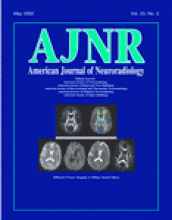Tullberg et al (1) concluded that the presence of deep white-matter hyperintensities and subcortical infarcts in patients with “normal pressure hydrocephalus” were not predictors of a poor outcome after shunt surgery. They further argued that white-matter abnormalities should not be used to exclude patients from surgery. I urge readers to be very cautious in accepting these conclusions from their study.
Subcortical infarcts and gliosis often render the cerebral white matter rubbery to palpation (2–4). The resiliency and support function of the tissues can be affected. Our experience and that of others is that ventricular shunting in patients with Binswanger-type subcortical disease leads to only temporary improvement. Symptoms and signs gradually return to their pre-shunting levels. The altered support of the ventricles does not maintain the reduced ventricular size. Furthermore, the microvascular disease often progresses, with worsening of neurologic signs (2–4).
Unfortunately, Tullberg and colleagues evaluated their 34 patients at 3 months after shunting. This is far too soon to determine if the surgery has any long-term benefits. Readers of the AJNR and I would be interested to know of any long-term follow-up in these patients.
Care must be used to separate periventricular, diffuse, smooth hyperintensities from irregular intensities around the frontal and occipital horns (which are often attributable to the transependymal passage of CSF). The latter findings are predictive of the response to shunting and are not caused by microvascular disease. Irregular white-matter lesions with extension limited to the corona radiata and centrum semiovale are attributable to microvascular disease that are predictive of only a temporary, limited benefit of surgery. The alteration in the physical properties of the supporting white-matter periventricular tissues in patients with microvascular (Binswanger) disease contribute to white-matter atrophy and ventricular enlargement.
Reply:
In his letter to the editor, Dr Caplan raises some valuable questions regarding the longer-term follow-up of the patients included in our recently published article (1). His experience is that, in patients with Binswanger-type subcortical disease, surgery leads to only temporary improvement. He urges the readers to be cautious in accepting our conclusions that vascular white-matter abnormalities must not be used to exclude patients from shunt surgery. He argues that our postoperative evaluation at 3 months after shunt surgery was performed too soon to evaluate the long-term benefit of the surgery.
We do agree that the long-term result of shunt surgery in patients with normal pressure hydrocephalus (NPH) is an important subject. We are in the process of completing the data analysis in a 5-year follow-up study of patients with NPH who underwent shunt surgery; these data will be published later. In our experience, however, most patients that improved 3 months after shunt surgery also maintained this improved at 12 months after surgery, unless shunt dysfunction occurred (2). During the past few years, we performed a quantified, clinical, 12-month postoperative evaluation of our patients. In the present study, 25 of the 34 patients included improved 3 months after surgery. Of these, 23 were re-evaluated 12–15 months after surgery (two patients refused re-evaluation). In 22 of the 23, the improvement remained the same as it was at the 3-month postoperative evaluation. The patient whose improvement was not maintained at 12 months after surgery had multiple cerebrovascular incidents, which explained the deterioration.
The group of patients with NPH that causes most diagnostic problems is the one with concomitant cerebrovascular disease. A shunt operation probably does not halt the progress of microangiopathy or prevent new cerebrovascular incidents. However, even a short period of improvement can be beneficial to an older patient, improving his or her quality of life for months or years.
- Copyright © American Society of Neuroradiology












